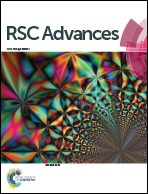Total synthesis of cruciferane via epoxidation/tandem cyclization sequence†
Abstract
The total synthesis of alkaloid cruciferane is performed in three steps with an overall yield of 60.3%. The key step involves the in situ epoxidation of indole followed by tandem Cyclization via epoxide ring opening to furnish the 3-hydroxypyrroloindoline skeleton. This methodology gave a step economical and protecting group free total synthesis of cruciferane.


 Please wait while we load your content...
Please wait while we load your content...